Tough and tunable adhesion of hydrogels: experiments and models
Author(s)
Zhang, Teng; Yuk, Hyunwoo; Lin, Shaoting; Parada Hernandez, German Alberto; Zhao, Xuanhe
Download10409_2017_661_ReferencePDF.pdf (1.268Mb)
OPEN_ACCESS_POLICY
Open Access Policy
Creative Commons Attribution-Noncommercial-Share Alike
Terms of use
Metadata
Show full item recordAbstract
As polymer networks infiltrated with water, hydrogels are major constituents of animal and plant bodies and have diverse engineering applications. While natural hydrogels can robustly adhere to other biological materials, such as bonding of tendons and cartilage on bones and adhesive plaques of mussels, it is challenging to achieve such tough adhesions between synthetic hydrogels and engineering materials. Recent experiments show that chemically anchoring long-chain polymer networks of tough synthetic hydrogels on solid surfaces create adhesions tougher than their natural counterparts, but the underlying mechanism has not been well understood. It is also challenging to tune systematically the adhesion of hydrogels on solids. Here, we provide a quantitative understanding of the mechanism for tough adhesions of hydrogels on solid materials via a combination of experiments, theory, and numerical simulations. Using a coupled cohesive-zone and Mullins-effect model validated by experiments, we reveal the interplays of intrinsic work of adhesion, interfacial strength, and energy dissipation in bulk hydrogels in order to achieve tough adhesions. We further show that hydrogel adhesion can be systematically tuned by tailoring the hydrogel geometry and silanization time of solid substrates, corresponding to the control of energy dissipation zone and intrinsic work of adhesion, respectively. The current work further provides a theoretical foundation for rational design of future biocompatible and underwater adhesives.
Date issued
2017-05Department
Massachusetts Institute of Technology. Soft Active Materials Laboratory; Massachusetts Institute of Technology. Department of Mechanical EngineeringJournal
Acta Mechanica Sinica
Publisher
Springer-Verlag
Citation
Zhang, Teng; Yuk, Hyunwoo et al. “Tough and Tunable Adhesion of Hydrogels: Experiments and Models.” Acta Mechanica Sinica 33, 3 (May 2017): 543–554 © 2017 The Chinese Society of Theoretical and Applied Mechanics; Institute of Mechanics, Chinese Academy of Sciences and Springer-Verlag Berlin
Heidelberg
Version: Author's final manuscript
ISSN
0567-7718
1614-3116